Streamlining Enterprise Architecture Development with the TOGAF Framework and Visual Paradigm’s Guide-Through Process
In the world of enterprise architecture, TOGAF® is a well-known and widely used framework that provides a comprehensive approach to designing, planning and implementing enterprise information technology architecture. Developed in 1995 by The Open Group, TOGAF® has become a globally recognized standard for enterprise architecture and is used by organizations of all sizes and types, including government agencies, financial institutions, and multinational corporations.
This article will provide an overview of the TOGAF® framework, its benefits, and how it can be used in practice.
Introduction to Enterprise Architecture
Enterprise architecture is the process of aligning an organization’s business goals and objectives with its information technology initiatives. The goal is to create a holistic view of the organization’s IT infrastructure, applications, and data in order to optimize business operations, reduce costs, and improve efficiency.
Defining Architecture in the Context of TOGAF
In the context of TOGAF®, architecture refers to the fundamental organization of a system, embodied in its components, their relationships to each other and to the environment, and the principles guiding its design and evolution. TOGAF® provides a common language and framework for describing and managing the architecture of an enterprise.
What is TOGAF®?
TOGAF® is an architectural framework that provides a comprehensive approach to the design, planning, implementation, and governance of enterprise information technology architecture. It is a globally recognized standard for enterprise architecture and is used by organizations of all sizes and types, including government agencies, financial institutions, and multinational corporations.
- TOGAF® deals with several types of architecture, including business architecture, data architecture, application architecture, and technology architecture. Each of these architectural domains is essential for creating a comprehensive view of the enterprise and for aligning IT initiatives with business goals.
- TOGAF® was developed by The Open Group in 1995 and has since become a widely adopted standard for enterprise architecture. It is a vendor-neutral framework that provides a common language and methodology for managing enterprise architecture.
The benefits of using TOGAF®
Using TOGAF® provides numerous benefits to organizations, including:
- Improved alignment between business and IT: TOGAF® helps to align business goals and objectives with IT initiatives, ensuring that IT investments are aligned with the overall strategic direction of the organization.
- Reduced costs and improved efficiency: By standardizing enterprise architecture practices, TOGAF® helps to reduce duplication of effort and improve efficiency, resulting in cost savings for the organization.
- Increased agility and flexibility: TOGAF® enables organizations to respond quickly and effectively to changing business requirements, allowing them to adapt to new market conditions and opportunities.
- Improved risk management: TOGAF® provides a framework for managing risk and ensuring compliance with regulatory requirements, reducing the potential for costly data breaches or other security incidents.
How TOGAF® is structured
The TOGAF framework consists of six major components, which are:

- The Architecture Development Method (ADM): This is the core of the TOGAF framework and provides a step-by-step approach to developing and implementing enterprise architecture.
- Architecture Content Framework: This provides a set of templates and models for creating and organizing architecture artifacts.
- Enterprise Continuum: This is a framework for classifying architecture artifacts and for developing and managing architecture assets.
- Architecture Capability Framework: This provides guidance on building and managing an effective architecture function within an organization.
- ADM Guidelines and Techniques: The ADM Guidelines and Techniques component provides practical guidance on how to apply the ADM effectively, tailoring it to the specific needs and goals of the organization. It ensures that best practices are consistently applied throughout the architecture development process.
- TOGAF Reference Models: These are pre-defined models that can be used to accelerate the development of architecture artifacts, such as the Technical Reference Model (TRM) and the Integrated Information Infrastructure Reference Model (III-RM).
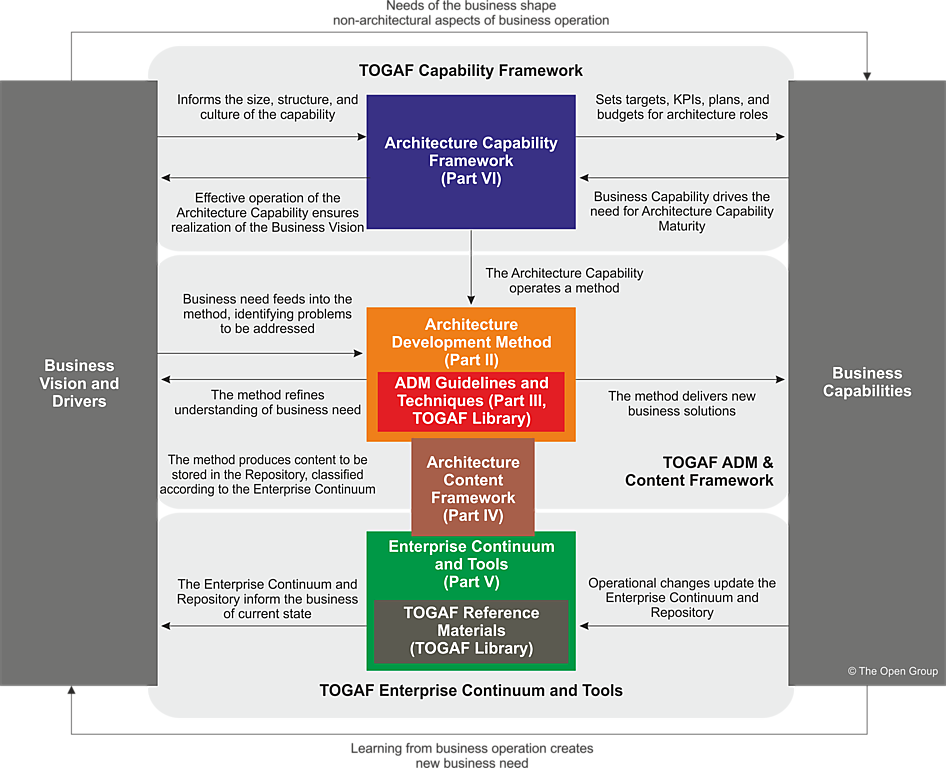
One of the benefits of dividing the TOGAF standard into independent parts is that it allows organizations to adopt specific parts of the framework based on their needs and goals. This means that organizations can select the parts of the framework that are most relevant to their specific situation, while excluding others.
For example, an organization may choose to adopt the ADM process to develop their enterprise architecture, but may not need to use the materials related to Architecture Capability if they already have an established architecture function in place. Similarly, an organization may choose to adopt the Architecture Content Framework to organize their architecture artifacts, but may not need to use the TOGAF Reference Models if they have already developed their own reference models.
The Architecture Development Method (ADM)
The Architecture Development Method (ADM) is the core of the TOGAF framework. It provides a step-by-step approach to developing and implementing enterprise architecture. The ADM is a comprehensive, iterative, and cyclical process that includes nine phases. The phases are as follows:
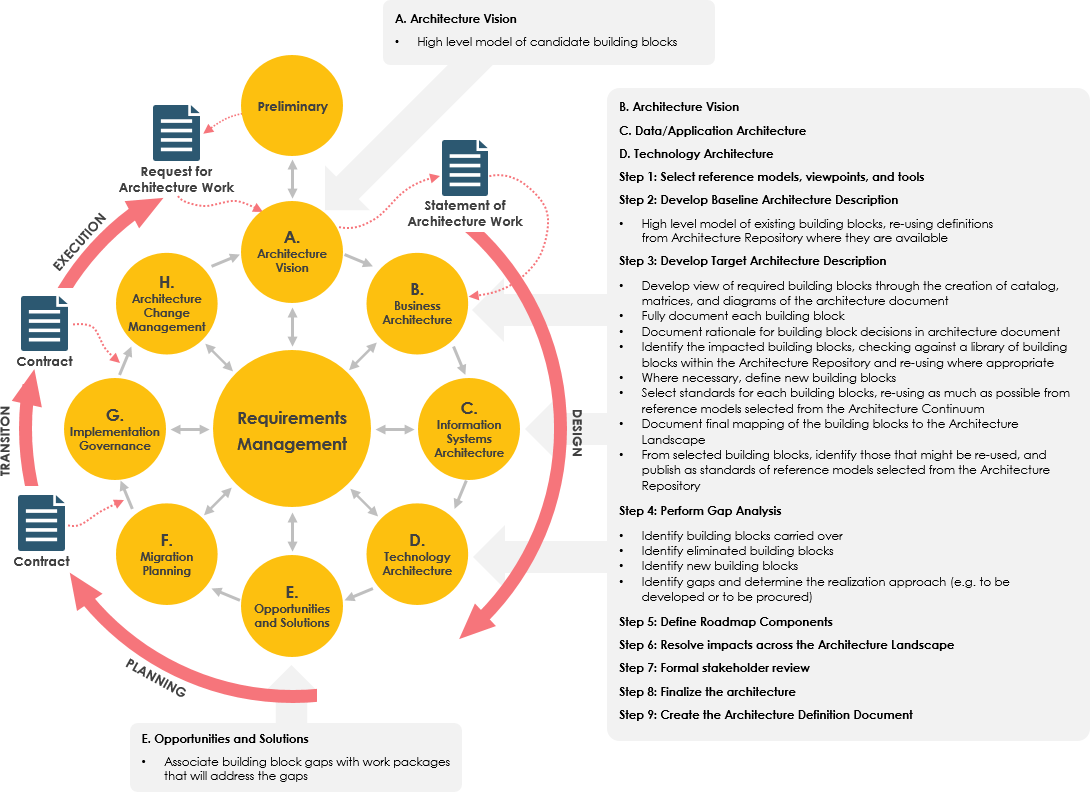
- Preliminary Phase -The first phase is the Preliminary Phase, which establishes the architecture vision, scope, and objectives.
- Phase A: Architecture Vision – This phase establishes the architecture vision, scope, and objectives.
- Phase B: Business Architecture – This phase develops a business architecture that describes the organization’s business strategy, goals, and processes.
- Phase C: Information Systems Architecture – This phase develops an information systems architecture that describes the organization’s information systems infrastructure, applications, and data.
- Phase D: Technology Architecture – This phase develops a technology architecture that describes the organization’s technology infrastructure.
- Phase E: Opportunities and Solutions – This phase identifies opportunities for improving the organization’s architecture and develops candidate solutions.
- Phase F: Migration Planning– This phase develops a migration plan for implementing the architecture.
- Phase G: Implementation Governance – This phase establishes governance processes for implementing the architecture.
- Phase H: Architecture Change Management– This phase manages the implementation of changes to the architecture.
- Phase I: Requirements Management – This phase manages the requirements for the architecture and ensures that they are met throughout the implementation process.
The ADM is designed to be flexible and can be tailored to meet the specific needs of an organization. It provides a comprehensive approach to developing and implementing enterprise architecture that ensures alignment with business goals and objectives.
Architecture Content Framework
The Architecture Content Framework is a key component of the TOGAF framework. It provides a structured approach to creating and organizing architecture artifacts. The framework defines a set of building blocks, templates, and models that can be used to create architecture artifacts that are consistent, complete, and reusable.
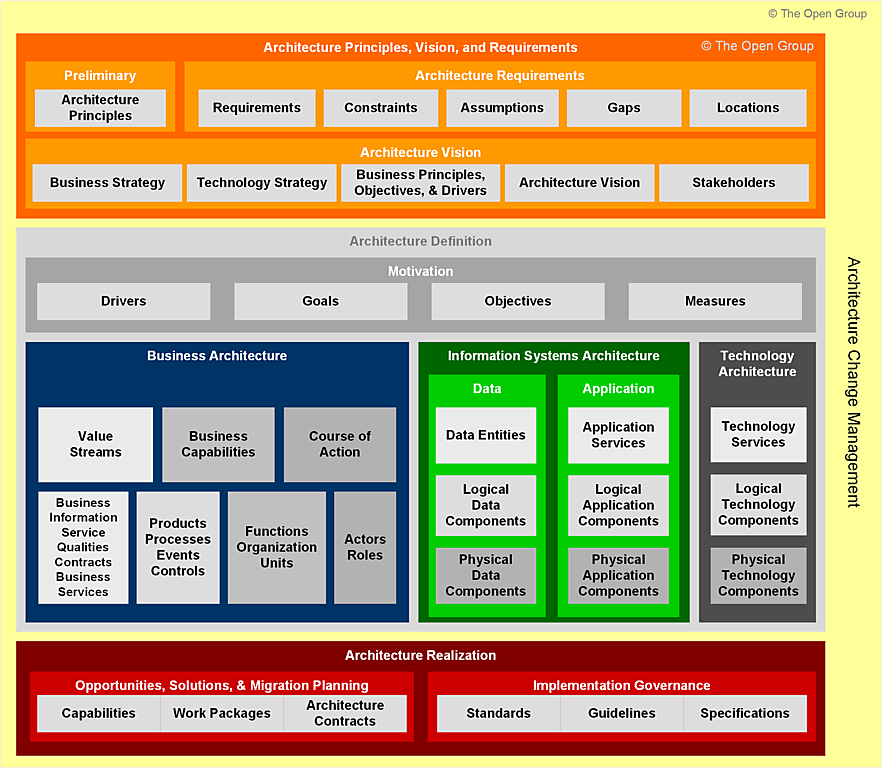
The Architecture Content Framework is organized into four levels, each of which provides a different perspective on the architecture:
- The Architecture Content Metamodel (ACM) – This is a formal description of the types of architecture artifacts that can be created and how they relate to each other. The ACM provides a common language for describing architecture artifacts and ensures that they are consistent and reusable.
- The Architecture Content Framework Taxonomy – This provides a high-level classification of architecture artifacts based on their purpose and context. The taxonomy includes categories such as business, data, application, and technology architecture.
- The Architecture Content Framework Deliverables – This provides a set of templates and models for creating architecture artifacts. The deliverables include architectural diagrams, matrices, and models that are used to describe the architecture.
- The Architecture Content Framework Artifacts – This provides a detailed description of each architecture artifact and its purpose. The artifacts are organized by category and include descriptions of their purpose, contents, and relationships to other artifacts.
The Architecture Content Framework provides a structured approach to creating and organizing architecture artifacts that ensures consistency, completeness, and reusability. It is an essential component of the TOGAF framework and is used throughout the architecture development process.
Enterprise Continuum
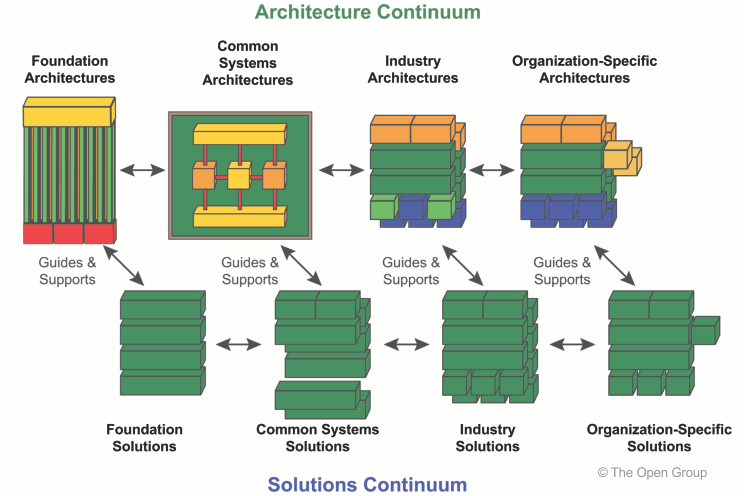
- The Architecture Continuum – This provides a way to organize architecture artifacts based on their level of abstraction, from the generic to the specific. The Continuum includes four levels: Business Architecture, Information Systems Architecture, Technology Architecture, and Product Architecture.
- The Solution Continuum – This provides a way to organize architecture artifacts based on their level of customization, from off-the-shelf solutions to fully customized solutions.
- The Industry Continuum – This provides a way to organize architecture artifacts based on their industry-specific characteristics and requirements.
- The Organization-Specific Continuum – This provides a way to organize architecture artifacts based on the specific characteristics and requirements of the organization.
The Enterprise Continuum helps organizations to manage their architecture assets and to ensure that they are aligned with the organization’s goals and objectives. It provides a structured approach to developing and managing architecture artifacts that ensures consistency, completeness, and reusability. The Continuum is an essential component of the TOGAF framework and is used throughout the architecture development process.
Architecture Capability Framework
The Architecture Capability Framework is a key component of the TOGAF framework. It provides guidance on building and managing an effective architecture function within an organization. This includes establishing an architecture governance framework and developing an architecture vision and roadmap.
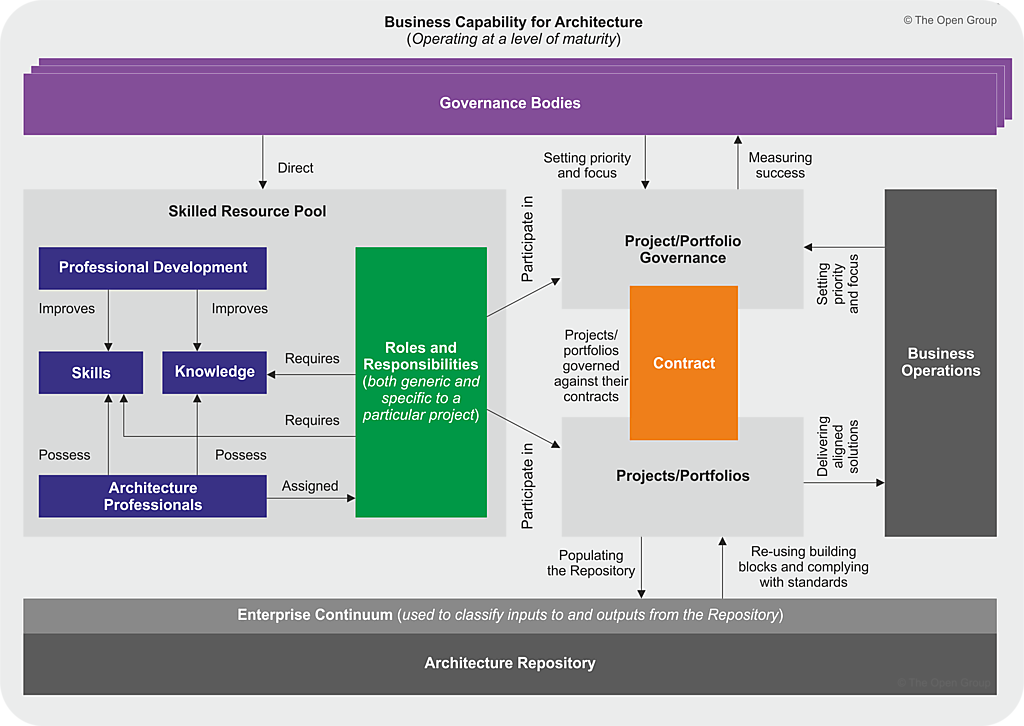
The Architecture Capability Framework consists of four components:
- Architecture Governance – This component provides guidance on establishing a governance framework for the architecture function. This includes defining the roles and responsibilities of the architecture team, establishing processes for managing architecture artifacts, and ensuring that the architecture function is aligned with the organization’s goals and objectives.
- Architecture Content Management– This component provides guidance on managing architecture artifacts and building blocks. This includes developing and maintaining an architecture repository, establishing processes for creating and managing architecture artifacts, and ensuring that architecture artifacts are consistent, complete, and reusable.
- Architecture Capability Building – This component provides guidance on building an effective architecture function within the organization. This includes developing the skills and capabilities of the architecture team, establishing processes for developing and implementing architecture, and ensuring that architecture is aligned with the organization’s goals and objectives.
- Architecture Change Management – This component provides guidance on managing changes to the architecture. This includes establishing processes for managing changes to the architecture, ensuring that changes are aligned with the organization’s goals and objectives, and ensuring that changes are communicated to stakeholders.
The Architecture Capability Framework provides a structured approach to building and managing an effective architecture function within an organization. It ensures that the architecture function is aligned with the organization’s goals and objectives and that architecture artifacts are consistent, complete, and reusable. The Framework is an essential component of the TOGAF framework and is used throughout the architecture development process.
Architecture Development Method (ADM) Guidelines and Technique
The Architecture Development Method (ADM) Guidelines and Techniques is a key component of the TOGAF framework. It provides practical guidance on how to apply the ADM to specific situations and contexts. The Guidelines and Techniques component includes a set of best practices, templates, and examples that can be used to support the architecture development process.
The ADM Guidelines and Techniques component includes guidance on how to:
- Tailor the ADM to specific situations and contexts.
- Conduct stakeholder management and communication.
- Develop business scenarios and use cases.
- Conduct architecture assessments and gap analysis.
- Develop architecture principles and standards.
- Develop architecture patterns and building blocks.
- Conduct architecture trade-off analysis.
- Develop implementation plans and roadmaps.
- Develop metrics and measurements for architecture.
The ADM Guidelines and Techniques component provides practical guidance that can help organizations to apply the ADM in a structured and effective manner. It ensures that the ADM is tailored to meet the specific needs and goals of the organization, and that best practices are applied throughout the architecture development process.
TOGAF Reference Models
The TOGAF Reference Models are a set of pre-defined models that can be used to accelerate the development of architecture artifacts. The reference models provide a common language and framework for describing and managing enterprise architecture. They include:
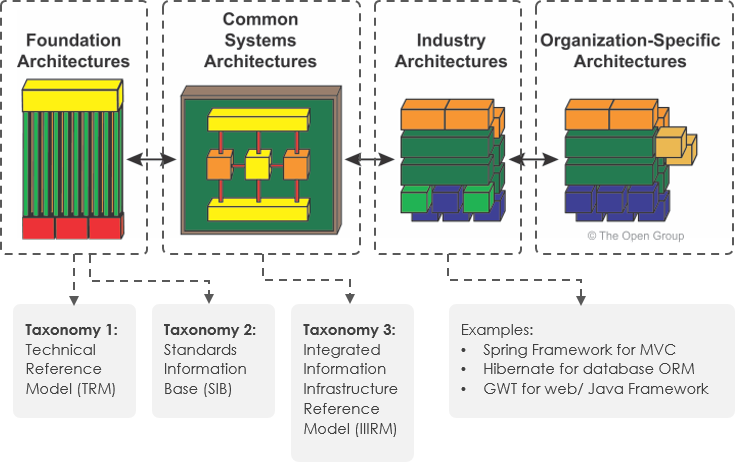
- The Technical Reference Model (TRM) – This provides a framework for classifying and organizing technology products and services.
- The Integrated Information Infrastructure Reference Model (III-RM) – This provides a framework for organizing application components and services.
- The Architecture Content Framework– This provides a framework for creating and organizing architecture artifacts.
- The Enterprise Continuum– This provides a framework for classifying architecture artifacts and for developing and managing architecture assets.
- The Architecture Development Method (ADM) – This provides a step-by-step approach to developing and implementing enterprise architecture.
The reference models are designed to be flexible and can be tailored to meet the specific needs of an organization. They provide a common language and framework for describing and managing enterprise architecture, which ensures consistency, completeness, and reusability. The reference models are an essential component of the TOGAF framework and are used throughout the architecture development process.
How can I quickly get started with TOGAF Projects and introduce it to my team?
Visual Paradigm is a modeling and design tool that supports the ADM process. It provides a range of features and tools that can be used to create and manage architecture artifacts, including diagrams, matrices, and models. The tool also provides support for architecture governance, stakeholder management, and reporting.
Visual Paradigm offers a range of editions, including Community, Standard, and Professional, which provide varying levels of functionality and support. The tool is designed to be user-friendly, with a range of tutorials, guides, and resources available to help users get started.
Overall, Visual Paradigm can be a useful tool for enterprise architects, whether they are beginners or experienced practitioners. However, it is important to evaluate the tool based on your specific needs and goals, and to consider other factors such as cost, usability, and support before making a decision.
What are the Benefits?
Visual Paradigm’s Guide-Through process is a feature that can help enterprise architects to apply the Architecture Development Method (ADM) in a structured and effective manner. The Guide-Through process provides step-by-step guidance throughout the architecture development process, ensuring that best practices are consistently applied.
Here are some benefits of using the Guide-Through process in Visual Paradigm:
- Structured approach – The Guide-Through process provides a structured approach to the architecture development process, ensuring that all necessary steps are completed and that best practices are applied.
- Tailored guidance – The Guide-Through process can be tailored to meet the specific needs and goals of the organization, ensuring that the ADM is applied in a way that is relevant and effective.
- Consistency – The Guide-Through process ensures that best practices are consistently applied, ensuring that architecture artifacts are consistent, complete, and reusable.
- Time-saving – The Guide-Through process can save time by reducing the need for manual intervention and providing pre-defined templates and models.
- Collaboration – Visual Paradigm’s Guide-Through process supports collaboration among team members, ensuring that all stakeholders are involved in the architecture development process.
One of the key benefits of the Visual Paradigm Guide-Through process is that it guides you through the completion of all the TOGAF standard artifacts and helps you automatically generate all the deliverables for each development phase. This can save time and ensure that all necessary artifacts are completed in a consistent and structured manner.
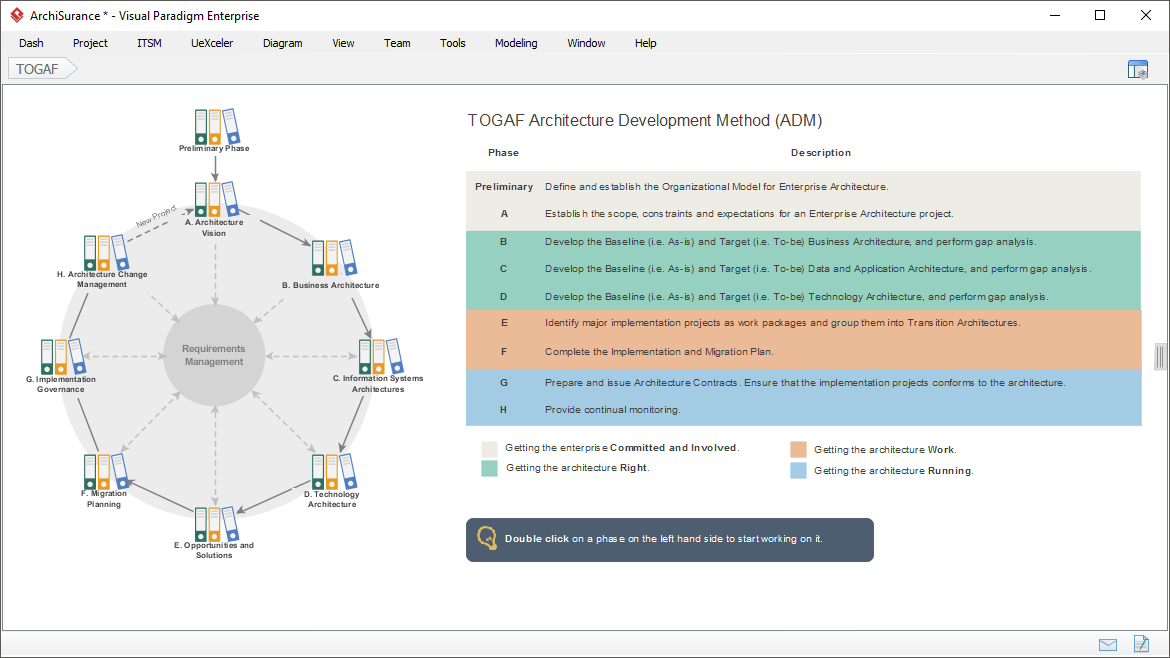
Overall, Visual Paradigm’s Guide-Through process can be a useful feature for enterprise architects, helping them to apply the ADM in a structured and effective manner. It provides tailored guidance, ensures consistency, saves time, and supports collaboration, all of which can lead to more effective and efficient architecture development processes.
Summary
The TOGAF framework is a structured approach to developing and managing enterprise architecture. It consists of six major components, including the Architecture Development Method (ADM), Architecture Content Framework, Enterprise Continuum, Architecture Capability Framework, TOGAF Reference Models, and Architecture Content Metamodel.
The ADM Guidelines and Techniques is a key component of the TOGAF framework and provides practical guidance on how to apply the ADM to specific situations and contexts.
Visual Paradigm is a modeling and design tool that supports the ADM process and provides a range of features and tools to create and manage architecture artifacts.
The Visual Paradigm Guide-Through process can help enterprise architects to apply the ADM in a structured and effective manner. It provides step-by-step guidance throughout the architecture development process, ensuring that best practices are consistently applied. The Guide-Through process can also save time by automatically generating deliverables for each development phase.

